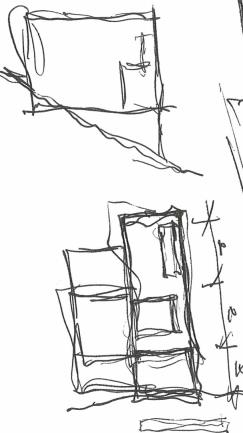The prospect of building your own home can be exciting, challenging, and provide a deep sense of ownership and achievement. For many, it is the fulfillment of a lifelong dream to create a custom environment fit for their very own lifestyle, a curated space with their very favorite amenities where they can make memories with family and friends for years to come. But when the dream fades and it's time to start thinking practically, this can quickly turn into a daunting task with no shortage of anxieties, frustrations, indecisions, and a general sense of confusion. While the process is far from perfect, it can be helpful to understand the basics from a “Where, What, and How” perspective.
Where To Build
The first step in building a home is to determine the site. Depending on your situation you may be most concerned about the school district, proximity to work and other business, or having access to parks and recreation facilities. Or, perhaps your priority is to own as much land as possible which may incline you toward a more rural and less developed area. The geographical location where you choose to build may change over time so it’s best to take that into consideration. Even 5 to 10 years can drastically change the landscape of an area that was once farmland, and what was a bustling neighborhood of new homes, manicured lawns, and freshly paved roads may not always look as pristine. However, some areas do age well and even grow in character and perceived value over time. In any case, it is important to remember that things do not remain static. So, even though the current needs may take precedence, at least consider what the future may bring and how long you intend to remain in that location.
Once you have a general idea of where you plan to build, the next step is to familiarize yourself with the local zoning requirements and any deed restrictions for your property. If you plan to build on a lot in a developing neighborhood then it’s a safe bet that the property is already zoned for residential use. It’s even more likely that the developer has some guidelines and restrictions on what you can and cannot build. Characteristics such as the size of the home and the building materials are often regulated within a neighborhood to maintain consistency. In addition, there may be HOA fees (homeowners association) and increased property tax rates in highly desirable areas. On the contrary, if you plan to purchase land that is not yet developed you may have complete freedom to build any size and type of home you want and you will likely have lower property taxes. However, it is still extremely critical to perform your own due diligence related to the zoning and building regulations. Certain properties must maintain a particular acreage per single-family dwelling and must adhere to designated setbacks from roads and easements. This will determine where the home can be situated on the property and will likely impact driveway access as well as the cost to run utilities to the home. A home that is set several hundred feet from a public road and existing utilities can easily add an additional $100k in costs.
What to Build
When thinking about building a house, size is always a question. You may ask - How much space do I really need? There are several outside factors that can determine your house size. As we mentioned previously, a neighborhood association, city zoning, and designated districts can all have a say in the square footage of your new house. It’s common to have minimum square footage requirements. Another more personal aspect that can play into the size of your new house is your lifestyle. Since you are designing your own home, it should support your lifestyle. Are you a couple starting out with plans of raising a family? Do you enjoy entertaining and hosting events regularly? Are you a single empty nester wanting to downsize? Are you active and need storage for your 5 bikes and two kayaks? When you think about your lifestyle it impacts your square footage, aesthetics, and layout requirement.
There is no need to build spaces you will not use frequently. Designers often use the phrase “don’t design for Christmas”. If you never host a formal dinner then you probably shouldn’t build a space for it. It’s common for a homeowner to head down the path of trimming and tweaking their design with the hopes of reducing costs. Reducing a design to help reduce square footage can be a good strategy to reduce cost. However, building products have typical dimensions, and it is good to keep them in mind as you reduce doing it in a way that doesn’t add waste.
The next question that inevitably arises is “do I need an architect?” Well, it depends. In some cases, you may have found a lot to purchase in a developer’s subdivision. If you are limited to working with one of the home builders in that subdivision you might have some limited options to alter the design to fit your aesthetics and lifestyle. In those cases, an architect would not be necessary. However, if you are looking at major changes to a floor plan, a custom house design, or building a house located in an area with site and neighborhood restrictions then an architect would be a great partner to navigate through the process. Working with an architect on a house design is often quickly dismissed by many homeowners thinking it’s a costly endeavor. A good rule of thumb is $2.25 per square foot for an architect to design your house. That cost can increase if there is any special structural engineering required. Examples would be increased footing requirements for poor soils or additional framing to support a roof deck or patio.
Considering your lifestyle can also inform what materials and finishes are used. Do you enjoy routine maintenance? Does your schedule allow time to paint, seal, or clean? If not, are you open to hiring such maintenance or would you rather have a maintenance-free construction? Many materials considered maintenance-free may not align with your aesthetic.
Advantages
Designing your own home has many advantages. One is that you can create a house that appeals to your own personal taste. Many homeowners use websites like Pinterest and Houzz as a means of capturing design elements that appeal to their aesthetic. These sites are always up to date with the latest trends. Such resources are a great way to determine your style and catalog that inspiration for future use. However, to avoid imagery overload, ask yourself why you like an image. It’s great to spend time filtering and understanding what it is that you like. Many homeowners may find an image that they really like and become frustrated when their design doesn’t look like the image. There are many exterior conditions, interior requirements, and budgets that impact the aesthetic of a house.
For example, a homeowner wanted their house to be like a charming modern farmhouse with a front porch found on Houzz. However, the homeowner’s particular lot was quite sloped. The interior layout would have dictated that the porch be placed on the back of the home. Furthermore, the charming modern farmhouse became quite tall on one end when placed on the sloped site and was orientated in the wrong direction. As a result, the house didn’t capture the essence of the image and lost the original design intent. The lesson here is that the most successful house designs have come from stepping back from the inspirational imagery, and simply embracing the uniqueness of the property, the view, the layout, and determining how it best supports the desired lifestyle. Ultimately this is what makes it your house.
How to Build
Perhaps by this time you have chosen a piece of land, and you are working with an architect to design the home of your dreams. In the final step, it is likely that you are going to need financing and a contractor to build your home. Depending on your experience and comfort level you may even be adventurous enough to act as your own general contractor and hire out the various components of construction on your own. This can be a great way to save some money since most home builders and general contractors will require a substantial fee for this service. After all, they are the pros, and this is their business. So, while it may save you thousands of dollars to oversee the build on your own, you need to have extensive knowledge of construction, building codes and have the time to oversee the progress which on average can take 8 to 12 months.
There is certainly a case to be made for allowing a professional builder to handle this for you. There is substantial risk involved in the process and things can quickly go sideways if you are unfamiliar with construction and don’t have the ability to properly vet the credentials of those that you hire to perform the various scopes of work.
In many cases, if you haven’t already started your own design, a builder will offer you a customizable portfolio of floor plans to choose from. It is typical for a home builder to work with clients to alter existing floor plans, bump out walls, increase storage, add an extra garage, etc. Most builders also offer interior design services to help with the selection of finish materials. Alternatively, you may choose to work with a custom or boutique builder that will construct whatever design you have prepared with your own architect and designer. In either case, it is well worth researching what builders fit your budget and style needs. Furthermore, you will want to make sure they have a good reputation for delivering a quality finished product, and that they have integrity within the local industry.
We have all heard stories of builders and contractors not delivering what was promised, or of lengthy delays and excuses for things not going as planned. An informed decision in selecting a quality builder can help you from becoming exasperated during the process.
Whether you are working through a builder or contracting the project yourself, you will most likely need to meet with a lender and determine the cost for the project, how much you are qualified to borrow, and how much you need to put down for the construction loan. Most lenders will require some type of qualifications if you intend to act as the general contractor to mitigate their level of risk. Once you are approved for the loan and construction commences your lender will fund the project as it progresses and may require project updates and inspections to ensure that the funding is commensurate with the degree of completion. You will continue to pay interest on the borrowed funds until eventually, you will convert your loan to a traditional mortgage once the home is complete and all inspections are passed. While borrow rates for construction loans are usually very reasonable, they are typically higher than that of a mortgage. So, the sooner your home is complete and the quicker you can convert to a traditional mortgage rate the better.
Final Thoughts
Building a home will inevitably bring challenges and provide plenty of learning opportunities. But it can also be extremely rewarding as many difficult things often are. The key to a pleasant building experience is to level-set your expectations at the outset. If you have taken the time to understand the basics of each phase of the process, and if you are prepared for some unknowns to surface, then you are well on your way to having a successful outcome. Building your own home really is as simple as putting one foot in front of the other. If you follow the steps, you can make your dream a reality.
























